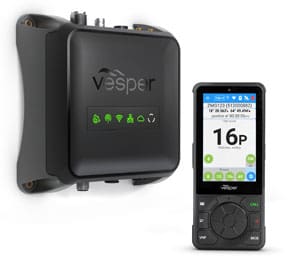Marine VHF radio has long been a communications device that just works. VHF radios have gotten steadily more capable with the addition of digital selective calling (DSC), and the integration of GPS and automatic identification system (AIS). The form factor for VHF has largely dictated the functionality of the classic VHF radio, with the combination display box/mic or the “walkie-talkie” handheld. Now, Vesper Marine — known for its AIS units — has made a play to reinvent VHF. Called Cortex, this black box-based product takes a page from the smartphone in its effort to produce a smarter, easier-to-use VHF.
Vesper’s contention is that modern VHF DSC radios rarely make calls in full DSC mode because it’s generally difficult to use. And thus, according to Vesper, the myriad communications and safety benefits of DSC are being ignored by boaters. “Cortex unleashes the full potential of VHF, AIS and DSC by combining them in a way that is both intuitive and super easy to use,” Carl Omundsen, Vesper’s chief technical officer, said in a press release.
Cortex combines VHF, AIS and vessel monitoring technology into one system. The brains of Cortex is the M1 black box unit that lives belowdecks. Its housing includes a specially designed plastic heat sink to remove excess heat. Inside the M1 is a GPS receiver along with microelectromechanical systems (MEMs) sensors that provide heading and acceleration data. Other sensors include barometer and battery sensors. The M1 also contains VHF radio circuits and a CPU to run the Cortex system software. The unit also provides a 10-watt external speaker output.
The other part of the Cortex system is an interesting recognition of the importance that smartphones and tablets have gained on board. The design of the IPX7-rated handsets is reminiscent of a smartphone. The top two-thirds of the unit is the full-color touch display made of Gorilla Glass, boasting touch functions that can be used while wearing gloves or even when the screen is wet. The lower third contains hardware buttons and a responsive click wheel. The hand-held unit can be either the wired H1 handset or the wireless H1P handset. The system can support up to 10 handsets, both wired and wireless.
The handset is the main display device for accessing the system’s three major functions of VHF DSC, AIS and vessel monitoring. When using the radio, the channel in use shows on the screen, and it is easy to use the click wheel to change channels or to initiate a DSC call. The handset can also be used to display the AIS situation, giving users a graphic chartplotter-type screen showing nearby vessels.
One of the main concepts behind the Cortex system is ease of use. Thus, for example, if you want to call a nearby vessel when using the AIS display, you can touch the screen and initiate a VHF DSC call while still monitoring the AIS situation on the screen. Cortex uses what Vesper calls “smartAIS,” which is designed to proactively alert boaters of potentially hazardous situations.
There’s also the vessel monitoring function. Using a boat’s onboard sensors via an NMEA 2000 network, various systems on board can be monitored. And when you’re off the boat, you can continue monitoring using the Cortex app on a smartphone. This monitoring capability includes an anchor watch function to help you check on the boat when ashore.
The system comes in various packages. The base package with the M1 core unit and one wired handset is $1,799. Vessel monitoring options start at the free basic package with the iOS and Android app and with position and sensor updates twice a day. Cortex monitoring capability is offered in the U.S., Canada, U.K., Europe, Australia and New Zealand. According to Vesper, that coverage area is set to expand in the future.

